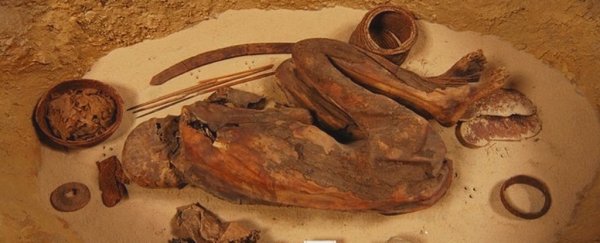It's confirmed. The ancient Egyptians were deliberately mummifying their dead long before we thought they had started the practice, and long before the Pharaonic period.
The first extensive tests conducted on an intact prehistoric mummy show that the practice was taking place up to 5,600 years ago - around 1,500 years earlier than previously accepted.
This incredible work is based on one of the oldest intact mummies in the world. Dating back to around 3700 to 3500 BCE, Mummy S. 293 (RCGE 16550) is the oldest preserved human body in the Egyptian Museum in Turin, Italy.
"Our findings represent the literal embodiment of the forerunners of classic mummification, which would become one of the central and iconic pillars of ancient Egyptian culture," said archaeologist and chemist Stephen Buckley of the University of York in the UK.
Mummy S. 293 had been in Turin since around 1900, purchased by Ernesto Schiaparelli without any documentation as to its provenance, but no one had conducted a detailed study of it, nor had it been the subject of any conservation treatments.
Previously, it had been thought that, like the Gebelein mummies, Mummy S. 293 was mummified naturally - that the heat, salinity and dryness of the Egyptian desert preserved the body, with no human intervention beyond burial.
The research team had previously found evidence of early mummification on funerary textiles. In a paper published in 2014, they explained that substances on mummy wrappings from prehistory were consistent with embalming agents.
But to confirm, they needed to work on an actual mummy. And S. 293, devoid of conservation chemicals, was the perfect subject.
They conducted a number of tests, including a visual assessment, radiocarbon dating of the textiles wrapped around the mummy, chemical analysis of textile samples via gas chromatography-mass spectrometry and thermal desorption/pyrolysis, and shotgun metagenomics to search for pathogens.
The chemical analysis revealed the presence of an embalming substance. This was made from a plant oil 'base', which was by far the dominant ingredient, mixed with a conifer resin imported from the Near East, an aromatic plant extract or 'balsam', and a plant gum.
These materials also included antibacterial agents, in similar proportions to those used by embalmers some 2,500 years later, when the mummifying practice was at its peak.
On top of that, an analysis of the textiles placed the burial site in southern Egypt, which suggests that the embalming recipe was more geographically widespread than previously thought, too.
"Having identified very similar embalming recipes in our previous research on prehistoric burials, this latest study provides both the first evidence for the wider geographical use of these balms and the first ever unequivocal scientific evidence for the use of embalming on an intact, prehistoric Egyptian mummy," Buckley said.
But it wasn't just the embalming substance the team found. They were also able to glean a few more pieces of information about the mummy - a more precise date for when he lived and died, how old he was, and whether he had any known diseases (the researchers couldn't find any, although the traces could have degraded over time).
"By combining chemical analysis with visual examination of the body, genetic investigations, radiocarbon dating and microscopic analysis of the linen wrappings, we confirmed that this ritual mummification process took place around 3600 BC on a male, aged between 20 and 30 years when he died," said Egyptologist Jana Jones from Macquarie University in Australia.
This precise timing places the mummy squarely in the early Naqada period.
"The examination of the Turin body makes a momentous contribution to our limited knowledge of the prehistoric period and the expansion of early mummification practices as well as providing vital, new information on this particular mummy," Jones said.
The team's research has been published in the Journal of Archaeological Science.
